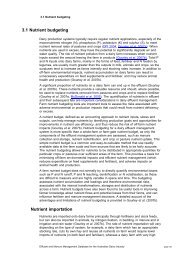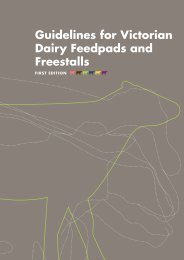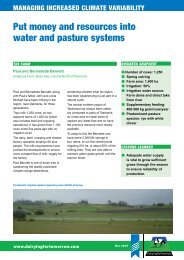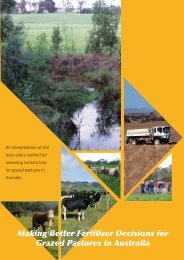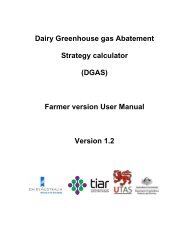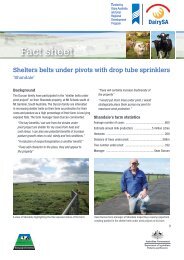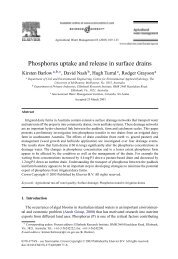Australian Dairy Industry In Focus 2009 - Dairying For Tomorrow
Australian Dairy Industry In Focus 2009 - Dairying For Tomorrow
Australian Dairy Industry In Focus 2009 - Dairying For Tomorrow
You also want an ePaper? Increase the reach of your titles
YUMPU automatically turns print PDFs into web optimized ePapers that Google loves.
y factors such as product and market<br />
mix, marketing strategies and processing<br />
efficiencies. The majority of milk prices<br />
are based on both the milkfat and protein<br />
content of the milk. Payments from<br />
processors to individual farmers can<br />
also vary marginally, as firms operate<br />
a range of incentive/penalty payments<br />
related to milk quality, productivity and<br />
off-peak supplies. There are also volume<br />
incentives in place to encourage milk<br />
supply to particular processing plants<br />
to improve operating efficiencies.<br />
The price farmers receive also varies<br />
across states, reflecting how milk is used<br />
in the marketplace. <strong>For</strong> example, many<br />
farmers in the southern regions receive<br />
a ‘blended’ price, incorporating returns<br />
from both drinking and manufacturing<br />
milk. However, higher prices are often<br />
received for year-round supply of milk<br />
under commercial contract arrangements<br />
in the northern dairy regions, where fresh<br />
drinking milk makes up a much larger<br />
proportion of the production mix.<br />
Farmgate prices reached record highs<br />
in 2007/08 and, despite falling 15%<br />
during 2008/09, remained well above<br />
those of previous seasons. However,<br />
the collapse in world dairy commodity<br />
prices during 2008 saw the almost<br />
unprecedented event of a step-down<br />
in farmgate milk prices during the season<br />
for the 75% of <strong>Australian</strong> dairy farmers<br />
who supply exporting companies. This last<br />
happened in 1973.<br />
Apart from the many factors affecting<br />
the milk prices received by individual<br />
farmers, as outlined in the preceding<br />
paragraphs, the value of the <strong>Australian</strong><br />
dollar in foreign exchange markets against<br />
the US dollar and the Euro is also critical<br />
in determining company returns. <strong>In</strong> the<br />
past decade, the <strong>Australian</strong> dollar has<br />
ranged in value against the US dollar from<br />
US$ 0.52 to more than US$0.90.<br />
The impact of currency changes on local<br />
returns is clearly shown in Figure 9. The<br />
<strong>Australian</strong> Export <strong>In</strong>dex represents the<br />
weighted average value of a ‘basket’<br />
of Australia’s major dairy exports<br />
compared to a baseline set at January 2000.<br />
Table 5<br />
Average annual milk production per cow<br />
NSW VIC QLD SA WA TAS AUST<br />
1979/80 2,870 3,012 1,984 3,163 3,105 2,958 2,848<br />
1989/90 3,602 3,920 3,122 3,934 4,205 3,791 3,781<br />
1999/00 4,827 4,989 4,349 6,790 6,338 4,381 4,996<br />
2000/01 4,687 4,977 3,943 6,369 5,903 4,177 4,859<br />
2001/02 5,030 5,391 4,067 5,933 5,402 4,646 5,215<br />
2002/03 4,996 4,885 4,230 6,556 5,348 4,304 4,913<br />
2003/04 5,093 4,944 4,162 6,021 5,285 4,219 4,925<br />
2004/05 4,925 5,101 3,735 5,862 5,418 4,497 4,983<br />
2005/06 5,039 5,221 4,076 5,791 5,369 4,581 5,108<br />
2006/07 5,151 5,261 4,033 6,417 5,235 4,696 5,182<br />
2007/08 (r) 5,031 5,393 4,163 5,799 5,907 4,961 5,275<br />
2008/09 (e) 5,532 5,864 4,995 6,142 6,326 5,303 5,750<br />
Source: <strong>Dairy</strong> manufacturers, ABS and <strong>Dairy</strong> Australia<br />
<strong>Australian</strong> <strong>Dairy</strong> <strong><strong>In</strong>dustry</strong> <strong>In</strong> <strong>Focus</strong> <strong>2009</strong> 13



